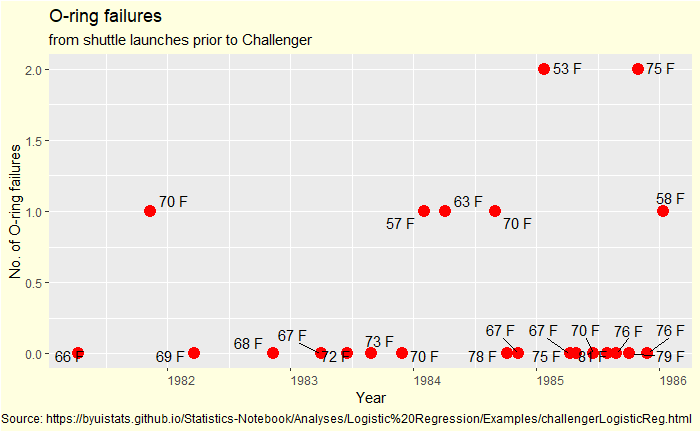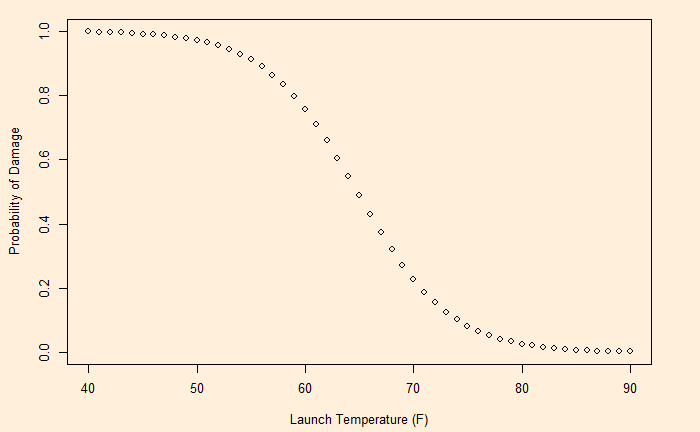Remember the post on the O-ring failure of the Challenger disaster?

Here, we do a step-by-step logistic regression of the data. The following table shows the O-ring damages and launch temperatures of 24 previous shuttle launches. Damage = 1 represents failure, and 0 denotes no failure.
| Flight # | Launch T (F) | O-ring Damage |
| STS 1 | 66 | 0 |
| STS 2 | 70 | 1 |
| STS 3 | 69 | 0 |
| STS 4 | 80 | 0 |
| STS 5 | 68 | 0 |
| STS 6 | 67 | 0 |
| STS 7 | 72 | 0 |
| STS 8 | 73 | 0 |
| STS 9 | 70 | 0 |
| STS 41B | 57 | 1 |
| STS 41C | 63 | 1 |
| STS 41D | 70 | 1 |
| STS 41G | 78 | 0 |
| STS 51A | 67 | 0 |
| STS 51C | 53 | 1 |
| STS 51D | 67 | 0 |
| STS 51B | 75 | 0 |
| STS 51G | 70 | 0 |
| STS 51F | 81 | 0 |
| STS 51I | 76 | 0 |
| STS 51J | 79 | 0 |
| STS 61A | 75 | 1 |
| STS 61B | 76 | 0 |
| STS 61C | 58 | 1 |
The logit function is:
![]()
The beta values (the intercept and slope) are obtained by the ‘generalised linear model’, glm function in R.
logic <- glm(Damange ~ ., data = challenge, family = "binomial")
summary(logic)Call:
glm(formula = Damange ~ ., family = "binomial", data = challenge)
Deviance Residuals:
Min 1Q Median 3Q Max
-1.0608 -0.7372 -0.3712 0.3948 2.2321
Coefficients:
Estimate Std. Error z value Pr(>|z|)
(Intercept) 15.2968 7.3286 2.087 0.0369 *
Temp -0.2360 0.1074 -2.198 0.0279 *
---
Signif. codes: 0 ‘***’ 0.001 ‘**’ 0.01 ‘*’ 0.05 ‘.’ 0.1 ‘ ’ 1
(Dispersion parameter for binomial family taken to be 1)
Null deviance: 28.975 on 23 degrees of freedom
Residual deviance: 20.371 on 22 degrees of freedom
AIC: 24.371
Number of Fisher Scoring iterations: 5The following plot is obtained by substituting the values 15.2968142 and -0.2360207 in the function.

Having developed the probabilities, now it’s time for decision-making. That is next.

